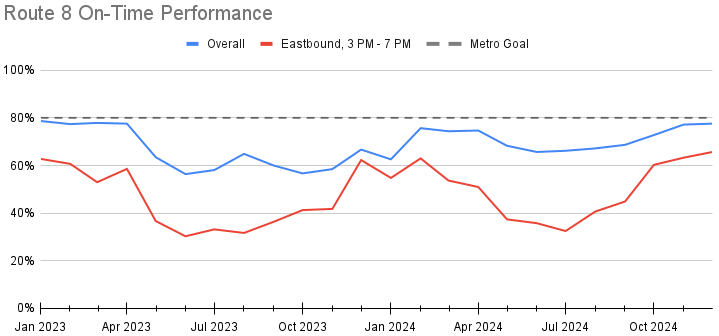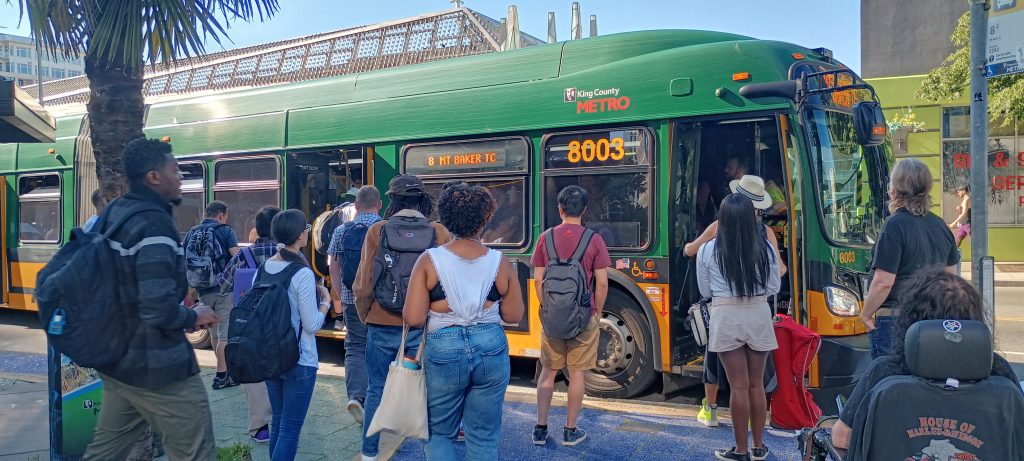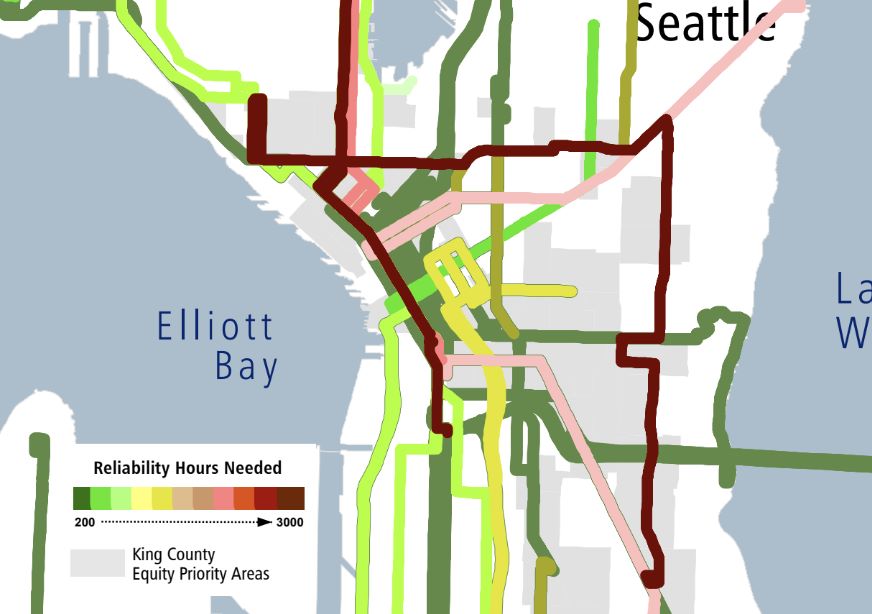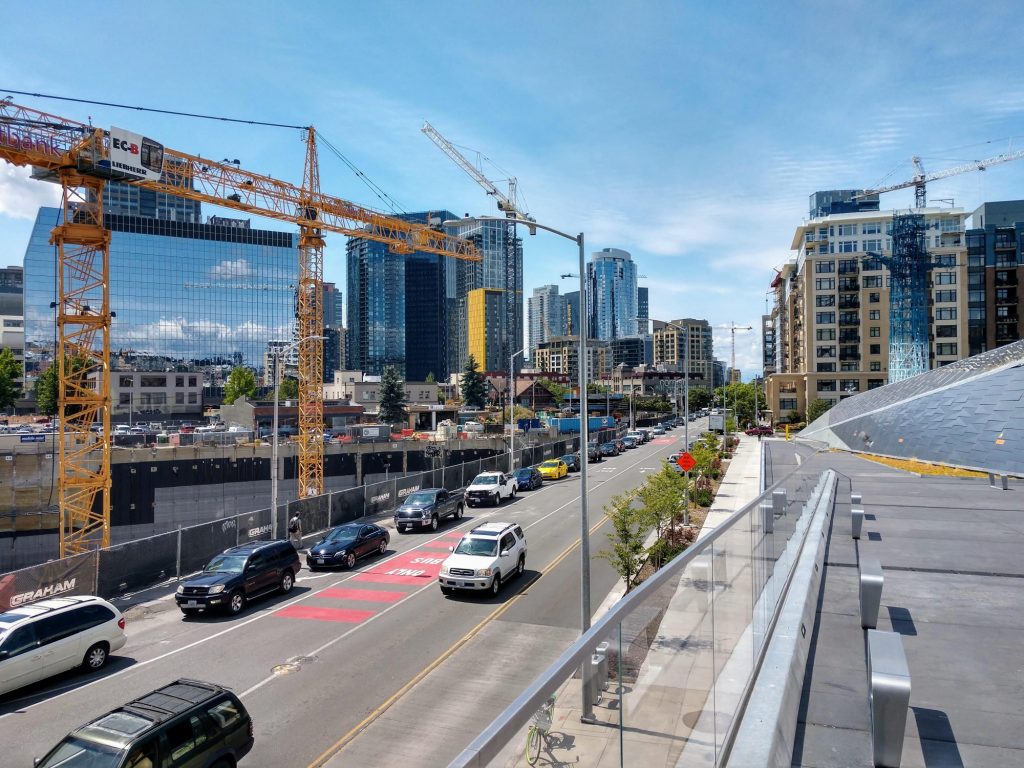
Sign our petition demanding speed and reliability improvements for King County Metro’s Route 8 bus.
If you rely on Route 8, Seattle’s crosstown bus route connecting Mount Baker and Lower Queen Anne via the Central District, Capitol Hill, and South Lake Union, you know that delays are chronic and rides can be slower than an average walking pace. You might be familiar with the unease that comes with huddling under the bus shelter with your neighbors, watching the estimated arrival time for the bus slip.
Even if the next bus does arrive in three minutes, everyone may not fit in the undoubtedly already-packed bus. Panic creeps in as the ETA passes the point of being late for work. You decide to give up on the bus that was supposed to be here eight minutes ago and start power walking past the bumper to bumper cars queued up along Denny Way. You finally arrive at your destination late, sweaty, and out of breath, and the bus is still nowhere in sight.
This experience isn’t unique and has earned the route the “L8” pejorative. In 2024, Route 8 served more riders per service hour during peak commute times than any other route. Many riders have expressed frustration with long waits, scrambled ETA data, and how they’ve resorted to long walks instead. And for those whose mobility limitations rule out walking, waiting for the L8 without an alternative can be even more excruciating.
It doesn’t have to be this way, and it shouldn’t. Help us with this effort by signing onto our action letter asking leaders to Fix the L8.

On paper, King County Metro is on board. The agency aims for 80% on-time reliability (within five minutes of scheduled stops) for all routes. But Route 8 is far from reaching this goal. It’s the second-least reliable route in the system on weekdays, according to King County Metro’s 2024 System Evaluation, with a third of weekday trips late.
Things look even worse for the evening rush hour, which sees an astounding display of inefficiency as drivers force their way through Seattle’s densest neighborhood, inching along toward the adjacent interstate. Motorists regularly block intersections, crosswalks, and bike lanes, creating a dangerous environment for non-drivers and obstructing traffic. The resulting gridlock delays up to 70% of eastbound buses by over five minutes, rendering Route 8’s estimated schedule useless.

Despite its bleak on-time performance, demand for Route 8 remains. More than 7,000 people per day boarded Route 8 last March, and ridership is only set to grow this year with Amazon’s recent return-to-office mandate. It’s completely unacceptable for a route with such high demand to have the worst reliability in the entire system.
That’s why Central Seattle Greenways partnered with the Transit Riders Union and launched a campaign urging the city and county to fix it. Through our campaign thousands of Route 8 riders sent letters demanding a solution. Despite promising initial momentum, the city continues to drag their feet on any meaningful improvements, so we remind leaders that Route 8 is one of Seattle’s most vital bus routes and it needs to run on time.
What’s happened since the first L8 Campaign push?
In early 2024, the Seattle Department of Transportation (SDOT), met with the Fix the L8 campaign and signaled that improvements were coming. They pointed to speed and reliability solutions, including future bus signal updates, turn restrictions for personal vehicles, and, importantly, extending the existing eastbound bus lane on Denny Way to Queen Anne Avenue. They also promised lighting, accessibility, and shelter upgrades to bus stops along the route, particularly on Martin Luther King Jr. Way, to bring stops to the minimum standard.
To implement the promised updates, SDOT first conducted a traffic analysis to pinpoint Route 8’s pinch points. Plagued by construction delays, the study concluded in late 2024. And to no one’s surprise, it confirmed that the L8 is agonizingly slow, averaging 3.5 miles an hour along Denny Way, the same as walking a brisk 17-minute mile.

The City has placed further reliability improvements on hold until SDOT can determine their impact on Denny traffic patterns. In the meantime, the department will move forward only with bus stop improvements beginning this summer.
While we agree bus stops should meet basic standards, it’s not clear how these will help bring the route to an acceptable on-time performance. After all, the most glaring issue plaguing the route remains: buses are constantly stuck in a traffic design that prioritizes personal cars. So far, nobody from SDOT, Metro, or city council have signaled they have a plan to address the problem. But someone should, and soon.
Upcoming Construction Woes – And a Missed Opportunity
The Denny Way Paving Project began construction March 26th and will last through the fall to replace 12 blocks of asphalt on Denny. While advocates hoped the design would include improvements both for Route 8 and for broader multi-modality options, including safety improvements that will help meet the city’s Vision Zero goals, the future of Denny appears to be mostly car-centric.
Construction will reduce Denny to one lane in each direction to complete work between 5th Ave and Stewart Ave. While SDOT has indicated that they will try to limit construction impacts by conducting work between 7pm and 6am, the work will no doubt result in travel headaches for all users – particularly for those who rely on Route 8.
When we asked the department about plans they have to maintain the route’s service levels, SDOT said flaggers will give priority to buses when they see one coming. This is wholly inadequate. Regardless of construction, Denny regularly clogs with car traffic, and by the time flaggers see a bus, it will already be delayed.
We know SDOT can do better. The department previously only required five days to design and install an emergency bus lane, and will add a new bus lane on Aurora during future Revive I-5 work. Route 8 deserves similarly ambitious changes to ensure it can continue running smoothly during construction, such as adding a temporary bus lane leading up to closures.
We encourage SDOT to be bold and go as far as to temporarily block the right turn to the Yale Avenue I-5 onramp during work hours to alleviate the primary source of traffic on Denny.
It’s time to Fix the L8
We continue to argue that prioritizing public transit benefits all modalities. If Route 8 maintained an average speed of just 10 mph, ridership would explode further as travel times between Queen Anne Avenue and Capitol Hill station would be slashed down to just 10 minutes. This is twice as fast as driving during rush hour, and a functioning, reliable Route 8 would replace a number of cars by turning would-be drivers into public transit users.
A dependable Route 8 will assist nearby businesses participating in Seattle’s Commute Trip Reduction Program while also alleviating King County Metro’ labor shortage by unlocking a more efficient route.

The city needs to get this right — and soon. In 2026, Seattle will be among the American hosts of the FIFA World Cup. While the influx of visitors will stress local transportation infrastructure, the event will serve as an opportunity to show other American cities that we can think beyond the automobile. We should be able to serve both the daily public transportation needs of locals while providing tourists a reliable alternative to the increased car-centered chaos that comes with hosting such a global event.
Additionally, Sound Transit is scheduled to open the transformational 2 Line light rail extension across I-90 later this year. The transit expansion will place a higher demand on Route 8 as it becomes one of only a few existing bus routes that will connect the future Judkins Park Station with the Central District. If outbound Route 8 buses remain caught in traffic, this vital connection cannot be called complete.
Finally, upcoming Revive I-5 work originally called for closing Mercer Street on-ramps for 25 days in 2026, although work was recently delayed. The closure will make Denny’s current congestion seem light as drivers reroute for the Yale on-ramp, and if Route 8 remains snarled in traffic without its own lane, then it will become unusable.

SDOT is not giving Route 8 the priority it needs to serve the growing number of riders and the fate of speed and reliability improvements depends on a traffic analysis that, like an 8 bus, is moving at a glacial pace.
Advocates had hoped the 2025 Levy Delivery Plan would address some of these failings, but it hardly mentions Route 8 other than to list a few spot improvements. And these are not likely to improve overall reliability as SDOT will likely forgo enlightened measures like full bus-only lanes without a blessing from city council. Meanwhile, the larger-scale transit improvements for Denny and Olive Way outlined in the voter-approved 2024 Seattle Transportation Levy are completely ignored. Looking even further, RapidRide candidate 1061, which covers much of Route 8, remains far beyond the horizon on the 2050 network list.
One of Seattle’s most vital bus routes is broken and needs to be fixed. The thousands of riders who depend on Route 8 deserve a reliable, functioning bus line. City council should mandate SDOT to designate bus-only lanes on Denny Way so that King County Metro can meet its own, extremely achievable 80% on-time metric and maintain an average speed of 10 mph to serve riders efficiently.
King County Metro should also prioritize RapidRide candidate 1061 to better serve this busy corridor, which is currently only slated for 2050. In the meantime, we are excited to see additional weekend service announced for Route 8 in its spring service changes and encourage additional frequency improvements to help meet demand.
If you’d like to support this effort beyond submitting a letter, please visit our campaign site for engagement opportunities as we continue to ramp up our efforts this spring.



